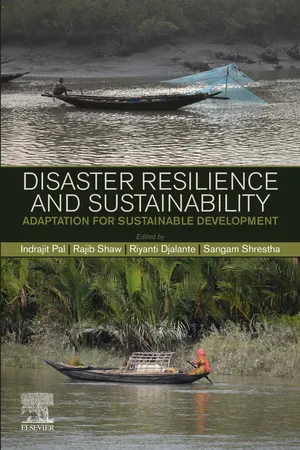
Disaster Resilience and Sustainability
Adaptation for Sustainable Development
- 834 pages
- English
- ePUB (mobile friendly)
- Only available on web
Disaster Resilience and Sustainability
Adaptation for Sustainable Development
About This Book
Disasters undermine societal well-being, causing loss of lives and damage to social and economic infrastructures. Disaster resilience is central to achieving the 2030 Sustainable Development Goals, especially in regions where extreme inequality combines with the increasing frequency and intensity of natural disasters.
Disaster risk reduction and resilience requires participation of wide array of stakeholders ranging from academicians to policy makers to disaster managers. Disaster Resilient Cities: Adaptation for Sustainable Development offers evidence-based, problem-solving techniques from social, natural, engineering and other disciplinary perspectives. It connects data, research, conceptual work with practical cases on disaster risk management, capturing the multi-sectoral aspects of disaster resilience, adaptation strategy and sustainability. The book links disaster risk management with sustainable development under a common umbrella, showing that effective disaster resilience strategies and practices lead to achieving broader sustainable development goals.
- Provides foundational knowledge on integrated disaster risk reduction and management to show how resilience and its associated concept such as adaptive and transformative strategies can foster sustainable development
- Brings together disaster risk reduction and resilience scientists, policy-makers and practitioners from different disciplines
- Case studies on disaster risk management from natural science, social science, engineering and other relevant disciplinary perspectives
Frequently asked questions
Information
Table of contents
- Cover image
- Title page
- Table of Contents
- Copyright
- Contributors
- Foreword
- Chapter 1: Toward sustainable development: Risk-informed and disaster-resilient development in Asia
- Chapter 2: Role of public policy in disaster risk reduction: A review
- Chapter 3: Transboundary water risk governance frameworks in deltaic socio-economic regions: A case study of river deltas in Bangladesh, India, and Vietnam
- Chapter 4: Framing the determinants of drought vulnerability in Malawian communities: An exposure, susceptibility, and capacity perspective from Karonga district
- Chapter 5: Disaster resilience and sustainability in South and South-East Asia: The politico-diplomatic equations of regional cooperation
- Chapter 6: Probabilistic seismic hazard assessment model for GIS-based seismic risk study of Thiruvananthapuram City
- Chapter 7: Assessment of groundwater vulnerability in highly industrialized Noyyal basin using AHP-DRASTIC and Geographic Information System
- Chapter 8: GIS-based landslide susceptibility zonation mapping using fuzzy gamma operator model in part of Trans-Asian Highway (Mao-Kangpokpi), Manipur, India
- Chapter 9: GIS perspective hazard risk assessment: A study of Fiji Island
- Chapter 10: Interannual and intraannual comparative study of sea surface temperature distribution over the Bay of Bengal, the Arabian Sea, and the Mediterranean Sea within the time frame of 2003–18
- Chapter 11: Flood damage assessment with multitemporal earth observation SAR satellite images: A case of coastal flooding in Southern Thailand
- Chapter 12: Ecosystem for disaster risk reduction in Bangladesh: A case study after the Cyclone “Aila”
- Chapter 13: Climate risk information as a basis for adaptive spatial planning: A case study from Thailand
- Chapter 14: Characterization of meteorological droughts in the Upper Bhima Catchment of Maharashtra State, India
- Chapter 15: Challenges in main streaming climate resilience in land-use planning: A case study in Malaysian local government
- Chapter 16: Identification of drought intensity and development of drought resilience in the Rayalaseema region of Andhra Pradesh, India
- Chapter 17: Assessing the impact of 2018 tropical rainfall and the consecutive flood-related damages for the state of Kerala, India
- Chapter 18: Coastal ecosystems and changing economic activities: Challenges for sustainability transition
- Chapter 19: Conceptualizing an integrated framework for natural hazards, insurance, and poverty nexus
- Chapter 20: Pre- and postdisaster human settlements in flood-prone urban areas: A focus on Thailand
- Chapter 21: Estimation of district-wise livelihood vulnerability index for the four coastal states in India
- Chapter 22: Assessing the role of a rehabilitated polder in sustainable agricultural development: A case study from Bangladesh
- Chapter 23: Risk reduction and resilience buildup in railroad transport
- Chapter 24: Salinity and the health of the poor in coastal Bangladesh
- Chapter 25: Assessing the impact of damage and government response toward the cyclone Gaja in Tamil Nadu, India
- Chapter 26: 2017 flash flood in Bangladesh: Lessons learnt
- Chapter 27: Effects of soil erosion on water quality: A case study from Uma Oya Catchment, Sri Lanka
- Chapter 28: Citizen sciences for smart water solution in South-western part of Bangladesh
- Chapter 29: Social capital and disaster risk reduction in a periurban context
- Chapter 30: Disaster risk reduction education (DRRE) and resilience in Asia-Pacific
- Chapter 31: In pursuit of a taxonomical definition of disaster diplomacy—An empirical scientometric analysis
- Chapter 32: Formal and nonformal disaster education interventions in Pakistan
- Chapter 33: Last mile communication of multihazard early warning—A case study on Bangladesh
- Author Index
- Subject Index